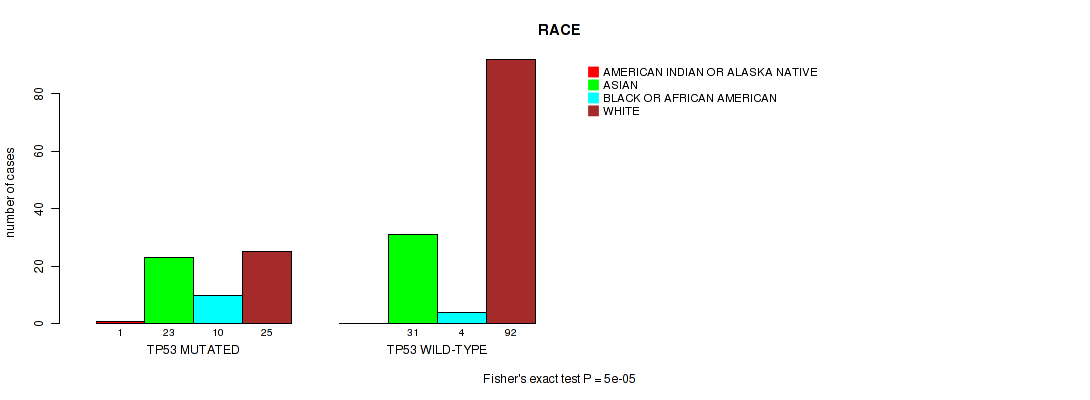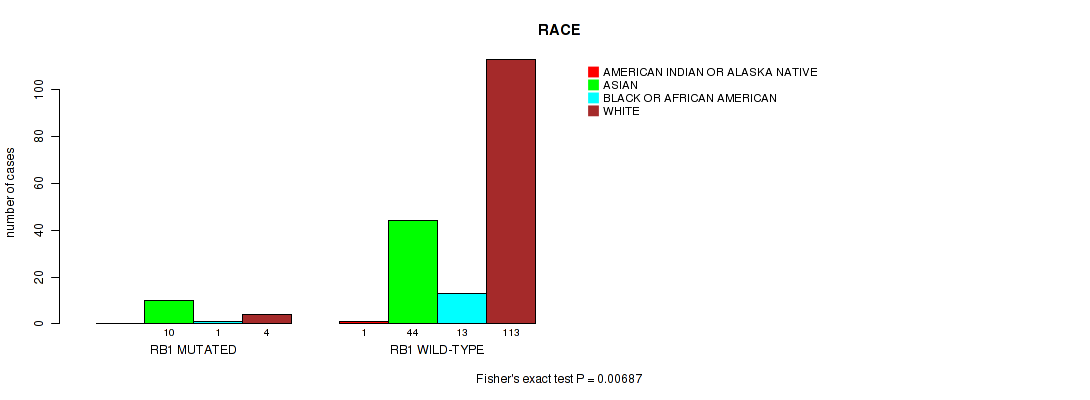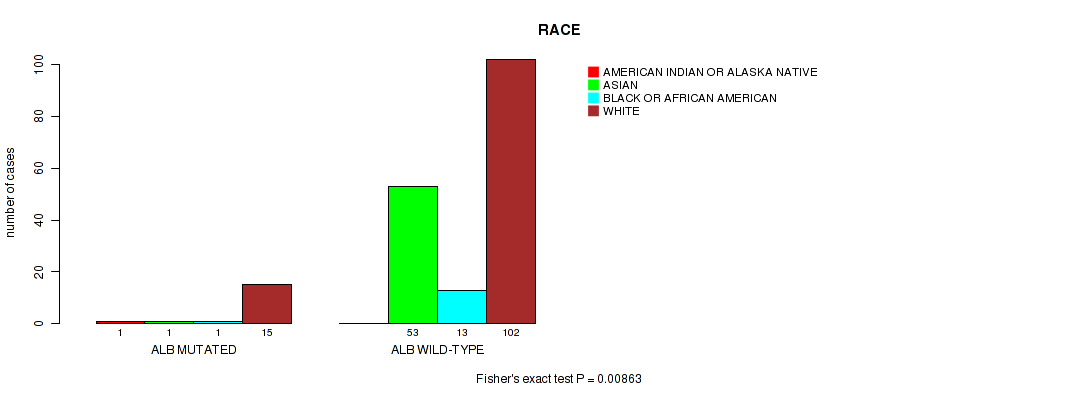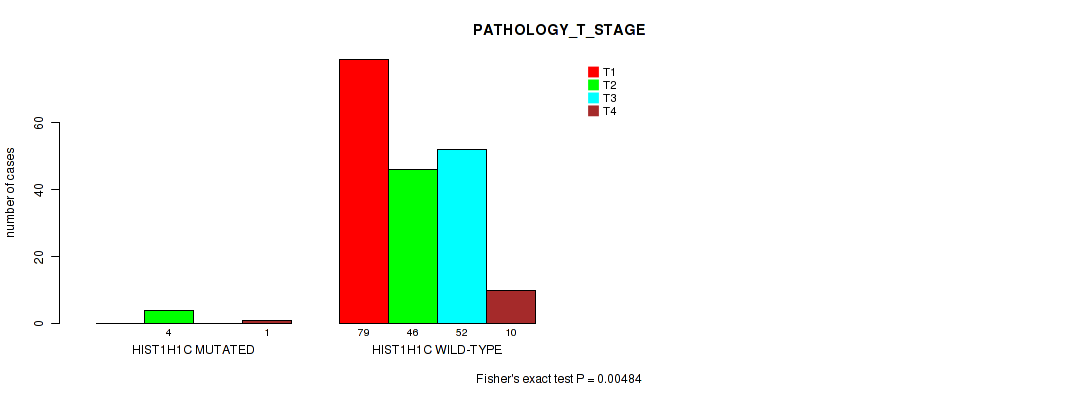This pipeline computes the correlation between significantly recurrent gene mutations and selected clinical features.
Testing the association between mutation status of 20 genes and 12 clinical features across 194 patients, 10 significant findings detected with Q value < 0.25.
-
TP53 mutation correlated to 'GENDER' and 'RACE'.
-
CTNNB1 mutation correlated to 'GENDER'.
-
RB1 mutation correlated to 'YEARS_TO_BIRTH' and 'RACE'.
-
ARID1A mutation correlated to 'Time to Death'.
-
BAP1 mutation correlated to 'GENDER'.
-
ALB mutation correlated to 'RACE'.
-
IL6ST mutation correlated to 'Time to Death'.
-
HIST1H1C mutation correlated to 'PATHOLOGY_T_STAGE'.
Table 1. Get Full Table Overview of the association between mutation status of 20 genes and 12 clinical features. Shown in the table are P values (Q values). Thresholded by Q value < 0.25, 10 significant findings detected.
|
Clinical Features |
Time to Death |
YEARS TO BIRTH |
PATHOLOGIC STAGE |
PATHOLOGY T STAGE |
PATHOLOGY N STAGE |
PATHOLOGY M STAGE |
GENDER |
RADIATION THERAPY |
HISTOLOGICAL TYPE |
RESIDUAL TUMOR |
RACE | ETHNICITY | ||
| nMutated (%) | nWild-Type | logrank test | Wilcoxon-test | Fisher's exact test | Fisher's exact test | Fisher's exact test | Fisher's exact test | Fisher's exact test | Fisher's exact test | Fisher's exact test | Fisher's exact test | Fisher's exact test | Fisher's exact test | |
| TP53 | 61 (31%) | 133 |
0.0849 (0.719) |
0.087 (0.719) |
0.396 (1.00) |
0.179 (0.86) |
0.559 (1.00) |
0.308 (1.00) |
0.00202 (0.114) |
1 (1.00) |
0.693 (1.00) |
0.96 (1.00) |
5e-05 (0.006) |
0.179 (0.86) |
| RB1 | 15 (8%) | 179 |
0.608 (1.00) |
0.00267 (0.114) |
0.455 (1.00) |
0.178 (0.86) |
1 (1.00) |
1 (1.00) |
0.404 (1.00) |
1 (1.00) |
1 (1.00) |
0.528 (1.00) |
0.00687 (0.206) |
0.358 (1.00) |
| CTNNB1 | 50 (26%) | 144 |
0.981 (1.00) |
0.208 (0.887) |
0.75 (1.00) |
0.598 (1.00) |
0.161 (0.86) |
1 (1.00) |
3.08e-05 (0.006) |
0.173 (0.86) |
0.681 (1.00) |
0.117 (0.799) |
0.293 (1.00) |
1 (1.00) |
| ARID1A | 17 (9%) | 177 |
0.00957 (0.23) |
0.198 (0.887) |
0.189 (0.872) |
0.633 (1.00) |
1 (1.00) |
1 (1.00) |
1 (1.00) |
0.22 (0.9) |
1 (1.00) |
0.297 (1.00) |
0.415 (1.00) |
1 (1.00) |
| BAP1 | 11 (6%) | 183 |
0.237 (0.912) |
0.712 (1.00) |
0.0478 (0.603) |
0.072 (0.709) |
0.181 (0.86) |
0.227 (0.9) |
0.000161 (0.0129) |
1 (1.00) |
1 (1.00) |
0.642 (1.00) |
0.898 (1.00) |
1 (1.00) |
| ALB | 18 (9%) | 176 |
0.541 (1.00) |
0.028 (0.517) |
0.241 (0.912) |
0.113 (0.799) |
0.243 (0.912) |
1 (1.00) |
0.0356 (0.57) |
1 (1.00) |
1 (1.00) |
0.403 (1.00) |
0.00863 (0.23) |
1 (1.00) |
| IL6ST | 7 (4%) | 187 |
0.00285 (0.114) |
0.17 (0.86) |
0.954 (1.00) |
0.867 (1.00) |
1 (1.00) |
1 (1.00) |
1 (1.00) |
0.115 (0.799) |
1 (1.00) |
0.687 (1.00) |
0.824 (1.00) |
1 (1.00) |
| HIST1H1C | 5 (3%) | 189 |
0.171 (0.86) |
0.88 (1.00) |
0.0434 (0.603) |
0.00484 (0.166) |
1 (1.00) |
1 (1.00) |
1 (1.00) |
1 (1.00) |
0.0991 (0.743) |
0.318 (1.00) |
0.0226 (0.452) |
1 (1.00) |
| AXIN1 | 9 (5%) | 185 |
0.0321 (0.551) |
0.799 (1.00) |
0.0929 (0.719) |
0.63 (1.00) |
1 (1.00) |
0.18 (0.86) |
1 (1.00) |
1 (1.00) |
1 (1.00) |
0.296 (1.00) |
1 (1.00) |
0.206 (0.887) |
| TSC2 | 9 (5%) | 185 |
0.989 (1.00) |
0.515 (1.00) |
0.179 (0.86) |
0.0768 (0.709) |
1 (1.00) |
1 (1.00) |
0.723 (1.00) |
1 (1.00) |
1 (1.00) |
0.549 (1.00) |
0.211 (0.887) |
0.183 (0.86) |
| APOB | 24 (12%) | 170 |
0.768 (1.00) |
0.543 (1.00) |
0.0615 (0.671) |
0.776 (1.00) |
0.375 (1.00) |
0.413 (1.00) |
0.503 (1.00) |
1 (1.00) |
1 (1.00) |
0.683 (1.00) |
0.0765 (0.709) |
1 (1.00) |
| PTEN | 7 (4%) | 187 |
0.341 (1.00) |
0.26 (0.945) |
0.85 (1.00) |
0.759 (1.00) |
1 (1.00) |
1 (1.00) |
0.425 (1.00) |
1 (1.00) |
1 (1.00) |
0.2 (0.887) |
0.457 (1.00) |
0.158 (0.86) |
| EEF1A1 | 5 (3%) | 189 |
0.0392 (0.588) |
0.326 (1.00) |
0.669 (1.00) |
0.386 (1.00) |
1 (1.00) |
1 (1.00) |
0.163 (0.86) |
1 (1.00) |
1 (1.00) |
0.561 (1.00) |
0.178 (0.86) |
1 (1.00) |
| KIF19 | 10 (5%) | 184 |
0.0916 (0.719) |
0.0452 (0.603) |
0.918 (1.00) |
0.64 (1.00) |
1 (1.00) |
1 (1.00) |
0.499 (1.00) |
0.161 (0.86) |
1 (1.00) |
0.596 (1.00) |
0.506 (1.00) |
1 (1.00) |
| THADA | 6 (3%) | 188 |
0.695 (1.00) |
0.0584 (0.667) |
0.919 (1.00) |
0.53 (1.00) |
1 (1.00) |
1 (1.00) |
1 (1.00) |
1 (1.00) |
0.12 (0.799) |
0.0928 (0.719) |
0.303 (1.00) |
1 (1.00) |
| PRKDC | 11 (6%) | 183 |
0.0169 (0.369) |
0.987 (1.00) |
0.434 (1.00) |
0.328 (1.00) |
1 (1.00) |
1 (1.00) |
1 (1.00) |
1 (1.00) |
1 (1.00) |
1 (1.00) |
1 (1.00) |
1 (1.00) |
| HNF1A | 8 (4%) | 186 |
0.674 (1.00) |
0.403 (1.00) |
0.229 (0.9) |
0.281 (0.993) |
1 (1.00) |
1 (1.00) |
0.458 (1.00) |
1 (1.00) |
1 (1.00) |
0.247 (0.913) |
0.689 (1.00) |
1 (1.00) |
| F5 | 4 (2%) | 190 |
0.844 (1.00) |
0.225 (0.9) |
0.624 (1.00) |
0.443 (1.00) |
1 (1.00) |
1 (1.00) |
1 (1.00) |
0.0503 (0.603) |
1 (1.00) |
1 (1.00) |
1 (1.00) |
1 (1.00) |
| GNAS | 7 (4%) | 187 |
0.266 (0.951) |
0.975 (1.00) |
0.686 (1.00) |
0.316 (1.00) |
1 (1.00) |
1 (1.00) |
1 (1.00) |
1 (1.00) |
1 (1.00) |
1 (1.00) |
0.689 (1.00) |
1 (1.00) |
| MLL4 | 10 (5%) | 184 |
0.986 (1.00) |
0.935 (1.00) |
0.976 (1.00) |
0.956 (1.00) |
1 (1.00) |
1 (1.00) |
1 (1.00) |
1 (1.00) |
1 (1.00) |
1 (1.00) |
0.0721 (0.709) |
1 (1.00) |
P value = 0.00202 (Fisher's exact test), Q value = 0.11
Table S1. Gene #1: 'TP53 MUTATION STATUS' versus Clinical Feature #7: 'GENDER'
| nPatients | FEMALE | MALE |
|---|---|---|
| ALL | 69 | 125 |
| TP53 MUTATED | 12 | 49 |
| TP53 WILD-TYPE | 57 | 76 |
Figure S1. Get High-res Image Gene #1: 'TP53 MUTATION STATUS' versus Clinical Feature #7: 'GENDER'

P value = 5e-05 (Fisher's exact test), Q value = 0.006
Table S2. Gene #1: 'TP53 MUTATION STATUS' versus Clinical Feature #11: 'RACE'
| nPatients | AMERICAN INDIAN OR ALASKA NATIVE | ASIAN | BLACK OR AFRICAN AMERICAN | WHITE |
|---|---|---|---|---|
| ALL | 1 | 54 | 14 | 117 |
| TP53 MUTATED | 1 | 23 | 10 | 25 |
| TP53 WILD-TYPE | 0 | 31 | 4 | 92 |
Figure S2. Get High-res Image Gene #1: 'TP53 MUTATION STATUS' versus Clinical Feature #11: 'RACE'

P value = 3.08e-05 (Fisher's exact test), Q value = 0.006
Table S3. Gene #2: 'CTNNB1 MUTATION STATUS' versus Clinical Feature #7: 'GENDER'
| nPatients | FEMALE | MALE |
|---|---|---|
| ALL | 69 | 125 |
| CTNNB1 MUTATED | 6 | 44 |
| CTNNB1 WILD-TYPE | 63 | 81 |
Figure S3. Get High-res Image Gene #2: 'CTNNB1 MUTATION STATUS' versus Clinical Feature #7: 'GENDER'

P value = 0.00267 (Wilcoxon-test), Q value = 0.11
Table S4. Gene #3: 'RB1 MUTATION STATUS' versus Clinical Feature #2: 'YEARS_TO_BIRTH'
| nPatients | Mean (Std.Dev) | |
|---|---|---|
| ALL | 192 | 60.1 (13.9) |
| RB1 MUTATED | 15 | 51.8 (11.3) |
| RB1 WILD-TYPE | 177 | 60.8 (13.9) |
Figure S4. Get High-res Image Gene #3: 'RB1 MUTATION STATUS' versus Clinical Feature #2: 'YEARS_TO_BIRTH'

P value = 0.00687 (Fisher's exact test), Q value = 0.21
Table S5. Gene #3: 'RB1 MUTATION STATUS' versus Clinical Feature #11: 'RACE'
| nPatients | AMERICAN INDIAN OR ALASKA NATIVE | ASIAN | BLACK OR AFRICAN AMERICAN | WHITE |
|---|---|---|---|---|
| ALL | 1 | 54 | 14 | 117 |
| RB1 MUTATED | 0 | 10 | 1 | 4 |
| RB1 WILD-TYPE | 1 | 44 | 13 | 113 |
Figure S5. Get High-res Image Gene #3: 'RB1 MUTATION STATUS' versus Clinical Feature #11: 'RACE'

P value = 0.00957 (logrank test), Q value = 0.23
Table S6. Gene #4: 'ARID1A MUTATION STATUS' versus Clinical Feature #1: 'Time to Death'
| nPatients | nDeath | Duration Range (Median), Month | |
|---|---|---|---|
| ALL | 192 | 88 | 0.0 - 114.3 (19.3) |
| ARID1A MUTATED | 16 | 11 | 0.3 - 60.9 (13.6) |
| ARID1A WILD-TYPE | 176 | 77 | 0.0 - 114.3 (19.6) |
Figure S6. Get High-res Image Gene #4: 'ARID1A MUTATION STATUS' versus Clinical Feature #1: 'Time to Death'

P value = 0.000161 (Fisher's exact test), Q value = 0.013
Table S7. Gene #6: 'BAP1 MUTATION STATUS' versus Clinical Feature #7: 'GENDER'
| nPatients | FEMALE | MALE |
|---|---|---|
| ALL | 69 | 125 |
| BAP1 MUTATED | 10 | 1 |
| BAP1 WILD-TYPE | 59 | 124 |
Figure S7. Get High-res Image Gene #6: 'BAP1 MUTATION STATUS' versus Clinical Feature #7: 'GENDER'

P value = 0.00863 (Fisher's exact test), Q value = 0.23
Table S8. Gene #7: 'ALB MUTATION STATUS' versus Clinical Feature #11: 'RACE'
| nPatients | AMERICAN INDIAN OR ALASKA NATIVE | ASIAN | BLACK OR AFRICAN AMERICAN | WHITE |
|---|---|---|---|---|
| ALL | 1 | 54 | 14 | 117 |
| ALB MUTATED | 1 | 1 | 1 | 15 |
| ALB WILD-TYPE | 0 | 53 | 13 | 102 |
Figure S8. Get High-res Image Gene #7: 'ALB MUTATION STATUS' versus Clinical Feature #11: 'RACE'

P value = 0.00285 (logrank test), Q value = 0.11
Table S9. Gene #9: 'IL6ST MUTATION STATUS' versus Clinical Feature #1: 'Time to Death'
| nPatients | nDeath | Duration Range (Median), Month | |
|---|---|---|---|
| ALL | 192 | 88 | 0.0 - 114.3 (19.3) |
| IL6ST MUTATED | 7 | 0 | 7.2 - 113.0 (56.2) |
| IL6ST WILD-TYPE | 185 | 88 | 0.0 - 114.3 (19.0) |
Figure S9. Get High-res Image Gene #9: 'IL6ST MUTATION STATUS' versus Clinical Feature #1: 'Time to Death'

P value = 0.00484 (Fisher's exact test), Q value = 0.17
Table S10. Gene #20: 'HIST1H1C MUTATION STATUS' versus Clinical Feature #4: 'PATHOLOGY_T_STAGE'
| nPatients | T1 | T2 | T3 | T4 |
|---|---|---|---|---|
| ALL | 79 | 50 | 52 | 11 |
| HIST1H1C MUTATED | 0 | 4 | 0 | 1 |
| HIST1H1C WILD-TYPE | 79 | 46 | 52 | 10 |
Figure S10. Get High-res Image Gene #20: 'HIST1H1C MUTATION STATUS' versus Clinical Feature #4: 'PATHOLOGY_T_STAGE'

-
Mutation data file = sample_sig_gene_table.txt from Mutsig_2CV pipeline
-
Processed Mutation data file = /xchip/cga/gdac-prod/tcga-gdac/jobResults/GDAC_Correlate_Genomic_Events_Preprocess/LIHC-TP/19897751/transformed.cor.cli.txt
-
Clinical data file = /xchip/cga/gdac-prod/tcga-gdac/jobResults/Append_Data/LIHC-TP/19775332/LIHC-TP.merged_data.txt
-
Number of patients = 194
-
Number of significantly mutated genes = 20
-
Number of selected clinical features = 12
-
Exclude genes that fewer than K tumors have mutations, K = 3
For survival clinical features, the Kaplan-Meier survival curves of tumors with and without gene mutations were plotted and the statistical significance P values were estimated by logrank test (Bland and Altman 2004) using the 'survdiff' function in R
For binary or multi-class clinical features (nominal or ordinal), two-tailed Fisher's exact tests (Fisher 1922) were used to estimate the P values using the 'fisher.test' function in R
For multiple hypothesis correction, Q value is the False Discovery Rate (FDR) analogue of the P value (Benjamini and Hochberg 1995), defined as the minimum FDR at which the test may be called significant. We used the 'Benjamini and Hochberg' method of 'p.adjust' function in R to convert P values into Q values.
In addition to the links below, the full results of the analysis summarized in this report can also be downloaded programmatically using firehose_get, or interactively from either the Broad GDAC website or TCGA Data Coordination Center Portal.